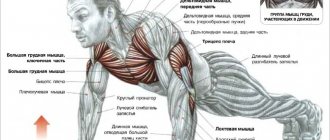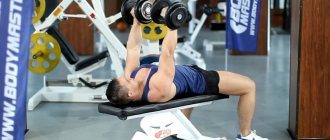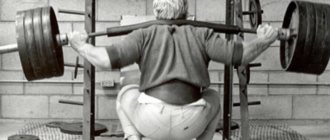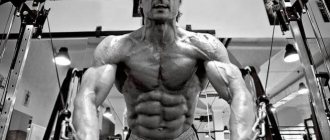If you don’t know how to do pull-ups yet, now is the time to learn. Pull-ups on the horizontal bar are an exercise that develops grip strength, increases the width of the back and helps elongate the spine.
They themselves are intermediate gymnastic movements. At the very beginning, lifting your own body weight seems like an impossible task, something completely incredible, but we will tell you how to start doing pull-ups on the bar from zero to 15-20 times in one approach.
You should not try to set goals to learn everything now and at once or look for something to replace this exercise. You must approach your goal gradually, without missing anything important. There are thousands of books on strategies and methods for learning how to do pull-ups from scratch, but not all of them can help you become really strong.
The method is designed so that a beginner can quickly train pull-ups from the simplest auxiliary exercises that will allow you to perform the first repetition from scratch to the most complex variations of this exercise.
How long does it take to learn?
If your body weight does not exceed 80-90 kilograms, then you can master the exercise and start doing it about 10 times in 2-3 weeks. If you are overweight, it is better to lose weight first. We recommend reading: how much weight you can lose in a month at home.
Choosing the optimal type of pull-up
Everyone who starts doing pull-ups on horizontal bars is concerned about the specific method of performing the exercise. Athletes recommend starting pull-ups with a regular grip technique. This is a kind of classic or base, from which it will then be easy to move on to varieties of pull-ups.
Types of pull-ups are designed in such a way that each of them is “responsible” for pumping different muscle groups. Therefore, ideally, you need to take your technique to a level where each workout you perform a series of exercises with a full set of grips.
Wide-grip pull-ups are considered the most difficult - unlike classic pull-ups, they involve more muscles. In turn, a direct grip works the trapezius muscles, and pull-ups with different grips help develop the shoulder muscle. Each type of pull-up on a horizontal bar deserves attention, so you shouldn’t limit yourself to just one type of exercise. It will be much more effective to combine techniques and types of grips in order to achieve an even load on the entire upper body.
Medium overhand grip
Correct technique:
- The width of the arms is slightly wider than the width of the shoulders;
- outer direction of the palms (overhand grip);
- arms bend at the elbows at the peak point;
- the chin is above the bar;
- at the lowest point the arms are straight.
The most important thing is to perform the exercise without swaying the body, evenly raising and lowering the body. It is necessary to bring your shoulder blades together in the process and try to touch the bar with your upper chest, pulling yourself up to the peak point. In order to better stretch the muscles, at the lowest point you need to fully straighten your arms.
Athletes also recommend lowering the body twice as slow as raising it, since elbow extension is the most difficult phase to perform.
If a person cannot yet lower himself smoothly, he needs the help of a partner who will support the body and help him rise and fall.
Load:
- biceps;
- trapezius muscles;
- latissimus dorsi muscles.
Medium underhand grip
Correct technique:
- The grip width should correspond to the width of the shoulders;
- palms facing yourself (lower grip);
- when pulling up, it is necessary to direct your shoulders back and down from the very beginning of the movement;
- at the highest point the chin is above the crossbar;
- at the lowest point the arms are straightened.
This option is simpler than the previous one, since when performing pull-ups with a medium grip from below, the biceps work more than the brachialis muscle. For beginners, as a rule, it is the biceps that are stronger, so it is recommended to take a closer look at this option if you belong to this category.
Load emphasis:
- biceps;
- latissimus dorsi muscles.
Wide grip to chest
Correct technique:
- a wide grip is approximately similar to that used in the barbell press;
- the projectile should be grasped from above with the thumbs, which will help to more effectively develop the back muscles;
- you need to smoothly bring your shoulder blades together and try to touch the horizontal bar with your upper chest;
- you should look straight up and bend your back;
- At the top point you need to linger a little.
Wide-grip chest pull-ups are the most difficult, but also the most effective exercise option. Even athletes sometimes make mistakes in their technique, which can lead to a decrease in efficiency. If you perform wide-grip pull-ups correctly, you can see results after a short period of time.
Load:
- trapezius muscles;
- top of lats;
- paired round.
Wide head grip
Correct technique:
- tightening should be gradual;
- grip width, as in the previous technique;
- When doing a pull-up, you need to bend your back and make your legs straight;
- It is important to point your elbows down, not back, throughout the entire execution.
Pull-ups with a wide grip behind the head are also popular, but also quite dangerous. If your joints have poor mobility, it is not worth doing. You should be especially careful with the wide-grip pull-up technique, since if you do it carelessly or ignore the correct method of doing it, you can get seriously injured.
The load is distributed among the following types of muscles:
- paired teres muscles;
- trapezoidal;
- the upper and middle part of the latissimus muscles.
Narrow overhand grip
Correct technique:
- The grip width should be narrower than shoulder width;
- at the highest point, the hands should be on both sides of the chin;
- it is necessary to pull yourself up, bending your back;
- at the highest point you should touch the horizontal bar with your chest.
Close-grip pull-ups are suitable for those with poor wrist mobility. It is noteworthy that the narrower the grip, the more load is placed on the biceps. Therefore, if you are interested in pumping up these particular muscles, this version of the technique will suit you much better than pull-ups with a wide or medium grip.
Muscles that are pumped in this technique:
- lower latissimus muscles;
- toothed;
- brachial muscle.
Narrow underhand grip
Correct technique:
- you should grab the horizontal bar with a reverse grip, if possible, put your palms together;
- hanging on straight arms, arch your back and look at your hands;
- during the pull-up process, focus on moving your shoulders back as much as possible and bringing your shoulder blades together;
- at the top point, try to bend your back even further to touch the projectile with your lower chest.
Close-grip pull-ups are good for pulling the lats downward. This technique is worth including in your routine if you are focused on varied approaches and pumping as many muscles as possible.
The horizontal bar grip exercise is considered one of the best for pumping up the biceps, as it works its peak. It is due to pumping the peak of the biceps that the arm appears more muscular and voluminous.
Emphasis on the following muscle groups:
- lower latissimus muscles;
- biceps.
Neutral grip along the bar
Correct technique:
- you need to grab the crossbar so that one fist is in front of the other crosswise;
- when pulling up, you should actively bend your back;
- on the way out, try to touch the horizontal bar with your lower chest;
- at the top point, you should take turns turning your head in different directions from the horizontal bar;
- Between approaches you need to change the position of your hands in order to provide different loads.
The technology is notable for the fact that the grip width can be either regular or narrow. Depending on the choice of grip, different muscles are pumped. This is why the grip along the bar is popular - each athlete can choose individual parameters for pumping the muscles he needs.
Responsible for this type of technology:
- lower latissimus muscles;
- toothed;
- brachial muscle.
Partial pull-ups with underhand grip
Correct technique:
- grab the bar with a medium reverse grip;
- pull yourself up exactly halfway;
- At the highest point, fix the body at an angle of 90 degrees to the floor, then bend your arms, trying to bring your collarbones as close as possible to the crossbar.
Partial pull-ups are aimed at high-quality development of the biceps due to the principle of load concentration. Maximum tension is achieved if you use a small range of motion and do not connect the stretching and resting points of the biceps. The correct technique for performing pull-ups with an underhand grip involves keeping the body in constant tension. This can be done due to incomplete bending of the elbows.
The load goes on the following muscles:
- biceps brachii muscles;
- biceps.
Problems when pulling up
Pull-ups on horizontal bars, like any other exercise, are fraught with the appearance of nuances and various problems at different stages of training. There are four categories of problems that you may encounter when performing the exercise:
| Category | Description | Recommendations |
| First | Can perform 1-2 pull-ups in one approach | The result is normal for a beginner. It indicates that it is too early to exercise with your own weight. To improve your skills, you need to start with the passive part of the pull-up:
It is recommended to do 3 sets of 5 repetitions at first; the process of lowering the body lasts 5-6 seconds. After a couple of weeks, you can reduce the number to two and lower the body more slowly. In addition, to make pull-ups easier, you can perform the exercise by resting your feet on the floor and gradually increasing the load on your arms. If you can’t reach the bar with your chin, you can do the lift halfway, just bend your elbows as far as the load allows. |
| Second | 2-4 reps per set | The second group should stretch the number of approaches and reduce the number of repetitions. At the same time, do not forget about the maximum intensity of pull-ups. Thanks to this, a large number of muscle fibers will be under load, and neuromuscular connections will be strengthened. The first two weeks you need:
After two weeks, it is recommended to perform 8 approaches as many times as possible, with the same break. An exercise called the “static hang” also helps. You must initially take a lifting position with your arms bent, and then try to hold your body at the top point for as long as possible and perform the descent. |
| Third | Best attempt – 5-7 times | The problem for people in the third category is that they have sufficient strength but insufficient endurance. The recommendations are as follows:
|
| Fourth | 8-12 reps per set | If you are in this category, then your body weight is too low for you. Therefore, it is necessary to use weights in training. These can be either special weights or any acceptable option. The main rule that must be followed is that the weight of the equipment should not be higher than 10% of its own weight. This load will help reduce the number of repetitions by 3-4. |
Benefits of Pull-Ups
Pull-ups on the horizontal bar have a positive effect not only on the condition of the muscles. They have a number of other positive aspects:
- When performing a pull-up, the body is in good shape, all muscles are tense and involved with a high load.
- The horizontal bar or crossbar on which the exercise is performed can be found not only in the gym, but also in any yard, which makes pull-ups incredibly accessible.
- Thanks to tightening, you can prevent the appearance and development of diseases such as scoliosis, lordosis, kyphosis.
- During the exercise, your posture improves significantly.
- The body quickly acquires relief.
- Pull-ups can be performed either as independent exercises or combined with other sports elements - in any case they will be effective.
- Depending on the execution technique and grip width, different muscle groups are pumped. Therefore, it is possible to select an individual technique and method of implementation to meet specific requests.
How to start doing pull-ups on the horizontal bar from scratch
Are you afraid of the crossbar? Are you scared of remembering the school gym? You are not alone. This movement remains a daunting exercise for many men. And this is bad, because few exercises can strengthen the entire upper body, affecting the core muscles and improving posture, like a simple pull-up.
Learning to perform this exercise correctly is important for any athlete, regardless of his goals. This is one of the most fundamental, basic exercises in the world of fitness. It is useful for both CrossFit and bodybuilding, and for sports enthusiasts. This exercise can be performed anywhere, either on the horizontal bar in the gym or on a tree branch in your yard. Pull-ups also target another muscle group you want to work: your back. Strong back muscles protect your shoulders from injury and also help all the other muscles in your body get the most benefit from other exercises, such as bench presses and curls.
But we must remember that technical pull-ups are difficult to learn for many reasons. First, you need to have mobility in your shoulder joints, which is difficult for many people to achieve. Secondly, you are lifting your entire body weight, which is simply not easy. Pull-ups can also be performed in different ways, making them even more challenging.
But we can explain everything to you. We will help you overcome all the difficulties that prevented you from correctly performing pull-ups - the gold standard of bodyweight exercises. And if you are still tormented by memories of the gym at school, you will find ways to overcome them too. It's time to step up to the bar and get to work.
Correct technique
The pull-up is a little more complicated than simply bringing your chin and bar together. You need to know the nuances that will allow you to strengthen your back and not harm your shoulders. The exercise can be viewed in three different phases: starting at the bottom, the middle position, and the top position, which is the most difficult position to pull.
Where to begin
Never let tension go away from your back. Your arms should be fully extended, but your body should not hang. Maintain constant tension in the shoulder muscles, the muscles around the shoulder blades and the collarbone. Don't let your body hang completely because your shoulders will end up near your ears. Then most of the load will fall on the relatively weak biceps ligaments - this is undesirable.
In the middle of the exercise
Watch your shoulder blades. When you start to pull up, don't just use your arms. Instead, engage other muscles—pull your shoulder blades down and back as your elbows move toward your ribs. "You control your shoulders and shoulder blades using the 'natural rhythm of the shoulder,'" says Jeff Cavaliere, physical therapist and trainer. This is the key to shoulder health and proper technical execution of the movement. In the video below, he explains the real reasons why you can't do pull-ups.
Have you reached the top? Do not stop
Try to finish the repetition. When your chin is over the bar, don't stop pulling. Try to rise higher by squeezing your shoulder blades. Pull even if you don't go higher. As you do this, try to keep tension in your glutes and abdominal muscles. Your torso may lean back slightly, causing your hips and legs to be in front of the bar. This is not a problem, but you should not push your shoulders in front of the horizontal bar. This can injure the shoulder muscles.
What difficulties might you encounter?
When learning to do pull-ups on a horizontal bar, a person may encounter problems caused by insufficient physical preparation.
Overweight
The higher your body weight, the more effort you have to put into lifting it. If your weight is much higher than normal and your muscles are weakened, studying will not be beneficial. It’s worth returning to it after losing weight, training your heart, and strengthening your muscles. Proper nutrition, exercise in the gym, and fat-burning programs help you get rid of excess weight. At the same time, they increase the overall level of physical fitness.
Physical weakness
Difficulties when doing pull-ups can also occur in people with normal body weight. In this case, we are talking about a lack of muscle mass, physical weakness, and lack of endurance. Solves the problem of muscle development by performing strength exercises. There are fitness projects that help you do this quickly. In a couple of weeks, a weak person becomes stronger and faster. Physical fitness training increases muscle mass to the level needed for pull-ups.
Weak muscles
When exercising on the horizontal bar, several muscle groups are used. The main ones are the biceps and the latissimus, the auxiliary muscles are the trapezoid, radial, deltoid, rectus, and serratus. By developing additional muscles, you can improve your physical fitness. The cause of problems with pull-ups often lies in the weakness of the auxiliary muscle tissues. To strengthen them, use special exercises on the crossbar or exercise machine.
Undeveloped technology
There are several recommendations that make it easy to master the pull-up technique. However, most of the tips are intended for those who are already familiar with this exercise. Often a person begins training using the wrong technique. You need to use special techniques that will help you quickly learn how to do pull-ups.
Hanging on the horizontal bar.
Which option is better and more correct?
There are three main types of pull-ups that are most often performed in gyms. There are classic full-hang variations in which you lower your torso until your arms are fully extended, and then pull up to the maximum. There are also constant tension pull-ups, which are especially popular with bodybuilders. When performing this variation, the athlete lowers himself, but not completely. Without relaxing the muscles, he begins the next repetition. Finally, there is also a rocking variation where you swing your hips to create momentum that will help you reach the bar. This variety is preferred in CrossFit.
Which version of pull-ups is better? This depends on your goal as well as the strength of your shoulder joints.
With full hang
At the beginning of the exercise, completely relax all the muscles of the shoulders and back.
Let's take a break. We'll pick up from here. Pro : You perform a full range of motion, which gives your back muscles a good stretch. And a pause will prevent you from cheating.
Con : The ligaments and tendons of the shoulder are at risk of injury or sprain.
With constant voltage
This is the gold standard of pull-ups; you must maintain tension in your back muscles. The most important thing is to get the most out of this exercise. Constant tension is not a reason to only go halfway. Your elbows should still be fully extended and your shoulders should be slightly less than fully relaxed.
Pros : You have the opportunity to strengthen your back and arms while not risking shoulder ligament damage.
Cons : This version is more difficult to complete than it seems at first glance. Eight such pull-ups will be difficult even for a physically developed person.
With rocking
This version of the exercise allows you to swing your hips (and, as a result, your shoulders). This gives you momentum, which makes lifting easier.
Pros : This option primarily develops endurance, although the upper body muscles are also stressed. Pull-ups are a difficult exercise, so twenty repetitions is almost impossible to complete. But if you add swinging, the number of repetitions becomes much higher.
Con : If your shoulders have poor stability, you can easily injure them. Think twice before doing such exercises. In order for such pull-ups to work well, you must first master the version with full hanging and constant tension.
Varieties of pull-ups
The following types of pull-ups are used:
- Straight grip. The palms are placed in the opposite direction from the body. This grip is considered the most convenient for beginners. The load falls on the broad back muscles.
- Reverse grip. Palms look at the person. It is easier to do pull-ups this way, because the main load is taken by the biceps, which help lift the body to the horizontal bar.
- Combined grip. One hand is placed in a straight position, the other in a reverse position. Such exercises are suitable for experienced athletes who want to diversify their loads. Change hands regularly during training.
- Neutral grip. Palms point towards each other. The load falls on the lower sections of the latissimus muscles.
Straight grip pull-ups.
Lead-up exercises
Very few people can step up to a bar and do a lot of pull-ups at once without a lot of preparation beforehand. Let us remember again that this is a rather complex technique; It's not easy to lift your own body weight over and over again.
But once you can master the simple pull-up, there are a whole host of variations you can try. Once you can complete the progression described above, you can experiment with the ideas outlined below. Some of them will help you do more pull-ups, and some will just be more difficult variations.
Tips and tricks for beginners
When training men and women, the following points should be considered:
- You cannot make sudden movements or jerks. Lifting the body is done through muscle strength. Don't simplify the task by swaying.
- It is not recommended to speed up the process of mastering a skill, especially if a person is learning from scratch. Hasty movements and too much stress lead to damage to the joints. They strive to improve the quality, and not to increase the duration of training.
- The smaller the body weight, the easier it is to maintain the position on the horizontal bar. Training should be combined with losing excess weight.
- When doing pull-ups or hangs, do not hold your breath. This way a person gets tired faster.
- The number of repetitions and approaches is increased gradually. The lesson plan is gradually becoming more complicated.
- Together with lead-up exercises, actions aimed at increasing endurance and physical strength are used. Push-ups will help smoothly prepare the muscles for pulling up on the horizontal bar.
- Using sports gloves prevents your hands from slipping off the machine.
- You cannot try to do more than 10 pull-ups in 1 approach. Beginner athletes are advised to dose their loads.
An important part of the lesson is the warm-up. Before going to the horizontal bar, warm up the muscles by running and jumping. After completing the workout, apply static stretching.
How to quickly learn to do a lot of pull-ups
Still studying?
Accelerate your progress by doing these 5 pull-up assistance exercises to start doing even more than 20 reps in one set: Hold : Stand on a box under the bar and jump up to the top position of the exercise. Hold there as long as possible, tensing your back muscles. Try to hold out for at least 20 seconds.
Reverse pull-up : Stand on a box under the bar and jump to the top position. Stay there for just a second. After this, begin to slowly lower yourself to the starting position. The lowering process should take at least five seconds. Perform three sets of five repetitions.
Horizontal pull-ups from hanging lying on a low bar : the bar should be low in relation to the floor. You can use any stick thrown between the chairs. Grab the bar and lean back so your torso is parallel to the floor, pressing into your heels and pulling your chest toward the bar. This is one repetition. You need to do three sets of fifteen repetitions. No, this is not the same as the classic exercise, but it will still help you develop the muscle strength needed to perform pull-ups correctly.
In addition to the techniques described, you can also perform these twice a week:
Low reps : Perform only one or two reps before lowering to the floor. In the first week, perform five sets of one repetition, and in the second week, perform four sets of two repetitions.
Lightweight option : here we will use an expander thrown over the crossbar. We put our feet on the expander so that it helps to do pull-ups. Try to do 2 sets of 8 repetitions.
Scapular pull-ups : While hanging from a bar, extend your arms. Squeeze your shoulder blades together. Hold for one second and relax. It was one repeat. Perform two sets of 10-15 repetitions.
Which leg position should you choose?
A little about the correct technique
In order for the muscles to be worked as efficiently as possible when doing pull-ups, you need to perform the exercise correctly. One of the main mistakes beginners make is not completing the exercise completely. When we say a “full” pull-up, we mean that when the highest point is reached, the collarbone should be at the level of the bar. There is no need to bend, throw your head back or tilt it forward.
When you reach the bottom, straighten your arm completely, then pause for a second and move up again.
Proper breathing technique is important. Do not hold your breath, breathe freely, but it is better to rise as you exhale, and to descend as you inhale.
Please note that when doing pull-ups, the arm muscles always work, but the lats only work when lifting from the bottom position. If you limit the amplitude and do not perform all stages of the exercise, then the back muscles will practically not take part in this process, and accordingly, it will not train either.
You may not be able to do a full pull-up at first. In this case, you can lower the horizontal bar lower (if possible) and push off with your feet, helping yourself to reach the top point. Try to lower your body as smoothly and slowly as possible until your arms straighten.
Another important point: no need to chase quantity. For beginners, it is better to do three pull-ups with perfect technique than twenty times, but absolutely incorrectly. You can master the exercise technique on a counterweight machine. Then you can start with push-ups with a reverse grip, which are considered the easiest, and then move on to a direct grip, varying its width. Then you can use weights. It will also be useful to supplement pull-ups on the bar with block rows on a special machine - this will help increase the effectiveness of your training.
For optimal muscle development, it is recommended to perform pull-ups 3-4 times a week . It is not advisable to exercise every day, as the muscles get used to the load. In addition, they need time to recover in order for them to actively grow. In general, pulling up on a horizontal bar, which muscles are pumped when doing it, you already know, is an excellent exercise that, when performed with the correct technique, is really effective. Alternate different types of pull-ups, and then you will be able to achieve harmonious muscle development.
Are you ready for difficulties? Try these varieties too
Loaded pull-ups : To get stronger you need to add intensity, not repetition. Try doing three sets of 10 reps while wearing a weighted vest.
Mixed-grip pull-ups : This is a more useful variation: grab the bar with one hand from below and the other from above. When performing the exercise, try to maintain balance. Don't let your hips move to the left or right.
Plyometric pull-ups : pull yourself up sharply and, reaching the top point of the exercise, throw yourself up and release the horizontal bar. Your hands should come off the bar. In a second, catch her again. Too easy? Try catching him with an underhand grip.
Cable pull-ups : Works the arm muscles, but this variation doubles the load on the hand muscles. We perform the movement holding the ends of the rope with both hands.
Pull-ups with corner hold : in the starting position, press your legs together and extend them forward, creating an L shape with your torso. Tighten your abdominal muscles. Keep your torso in this position as you perform pull-up reps.
Archer Pull-Ups : As you rise, shift your torso to the left side, extending your right arm as your chest approaches the bar. Lower yourself, then do the same on the other side with your left arm straight.
What are the contraindications?
If you have health problems, you should avoid exercising on the horizontal bar. Contraindications are scoliosis, spondyloarthritis, intervertebral hernias and protrusions. Approach training with caution if you have osteochondrosis.
Despite the fact that exercise increases blood supply and develops joints, during degenerative processes it puts extra stress on the spine.
With cervical osteochondrosis, pull-ups can provoke increased pain.










